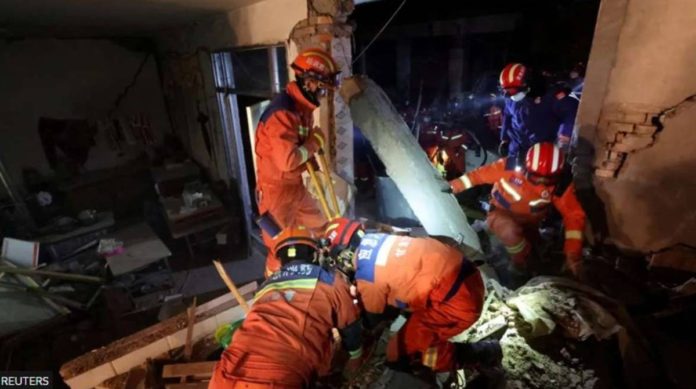
BEIJING – At least 127 people have been killed in north-west China in the country’s deadliest earthquake for years.
The 6.2 magnitude quake hit mountainous Gansu province around midnight on Monday, also shaking neighboring Qinghai.
Fatalities may rise, with more than 700 reported injured in icy conditions.
Chinese President Xi Jinping has ordered thousands of rescue crew to the region, among the poorest and most diverse in China.
The earthquake is the country’s deadliest since 2014, when more than 600 people were killed by a quake in south-western Yunnan province.
On Tuesday, footage shown on state TV and social media networks showed entire villages split by the quake, as well as collapsed buildings and houses.
Residents who fled their homes were also shown huddling over makeshift fires at hastily erected evacuation camps. Temperatures hit -13C on Tuesday, Chinese media reported.
Survivors said the tremors had felt like “being tossed by surging waves” and recalled rushing out of their apartments.
“I woke my family up and we rushed down all 16 floors in one breath,” said one man named Mr Qin by Chinese outlets.
Local officials in Jishishan county, the worst-hit in Gansu province, said more than 5,000 buildings in the area had been damaged. Many other buildings in the province have been hit by mudslides triggered by the quake, while dozens of roads have been damaged by landslides.
Chinese media quoted a director of the Gansu rescue team, who attributed the widescale damage to poor building quality in the villages – many homes being old and made of clay.
Gansu lies between the Tibetan and Loess plateaus and borders Mongolia. The remote region is one of China’s poorest and most ethnically diverse.
The epicenter of the quake was in Linxia Hui Autonomous Prefecture, home to many Chinese Muslim groups, including the Hui, Bonan, Dongxiang and Salar people.
Chinese authorities said the quake measured 6.2 on the Richter scale, while the US Geological Survey (USGS) recorded a magnitude of 5.9 and depth of 10km (6 miles). About 10 aftershocks have taken place, local authorities reported.
On Tuesday, Xinjiang, the province west of Gansu, also recorded a 5.5 magnitude quake – but there were no immediate reports of casualties.
Across the region, power and water supplies have been disrupted, hindering rescue efforts.
Officials say they have limited time left to rescue people in the sub-zero conditions.
“It is too cold to bear… it’s -15C [here],” Wang Yi, chief commander of the Blue Sky Rescue Team, told the BBC. Blue Sky is China’s largest non-governmental humanitarian organisation, with more than 30,000 volunteers across the country.
Wang said he expected the number of casualties to climb. “We now need to dig deeper [into the rubble]. But there are no big buildings in the area. So it will rise, but it won’t be much,” he said.
President Xi has said “all efforts should be made to carry out search and rescue, treat the injured in a timely manner, and minimise casualties”.
China sits in a region where a number of tectonic plates – notably the Eurasian, Indian and Pacific plates – meet. It is particularly prone to earthquakes.
An earthquake in Yushu in Qinghai province, which is next to Gansu, claimed almost 2,700 lives in 2010.
China’s most devastating earthquake in recent decades was in the south-western province of Sichuan in 2008 when 87,000 people were killed. (BBC)







